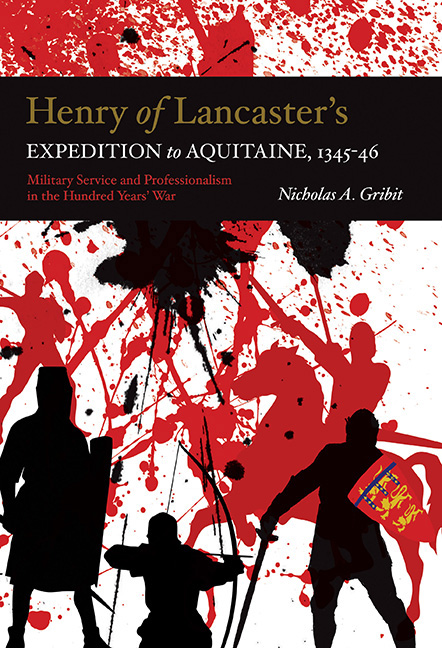 Henry of Lancaster's Expedition to Aquitaine, 1345-1346
Henry of Lancaster's Expedition to Aquitaine, 1345-1346 Book contents
- Frontmatter
- Dedication
- Contents
- List of Illustrations
- Preface and Acknowledgements
- Abbreviations
- Note on Money and Names
- Introduction
- Part I Henry of Lancaster and the English Army: Soldiers, Payment and Recruitment
- Part II The English Expedition to Aquitaine, 1345–46
- Part III Military Service and the Earl's Retinue for War
- 7 Lancaster's War Retinue in 1345: Formation and Structure
- 8 Lancaster's War Retinue in 1345: Cohesion and Stability
- 9 An Era of Military Professionalism: Careers and Patterns of Service
- Conclusion
- Appendix A Transcription and Translation of Lancaster's Indenture
- Appendix B Prosopographical Catalogue of Men in Lancaster's War Retinue, 1345–46
- Bibliography
- Index
- Warfare in History
7 - Lancaster's War Retinue in 1345: Formation and Structure
from Part III - Military Service and the Earl's Retinue for War
Published online by Cambridge University Press: 05 July 2016
- Frontmatter
- Dedication
- Contents
- List of Illustrations
- Preface and Acknowledgements
- Abbreviations
- Note on Money and Names
- Introduction
- Part I Henry of Lancaster and the English Army: Soldiers, Payment and Recruitment
- Part II The English Expedition to Aquitaine, 1345–46
- Part III Military Service and the Earl's Retinue for War
- 7 Lancaster's War Retinue in 1345: Formation and Structure
- 8 Lancaster's War Retinue in 1345: Cohesion and Stability
- 9 An Era of Military Professionalism: Careers and Patterns of Service
- Conclusion
- Appendix A Transcription and Translation of Lancaster's Indenture
- Appendix B Prosopographical Catalogue of Men in Lancaster's War Retinue, 1345–46
- Bibliography
- Index
- Warfare in History
Summary
If ‘the size and splendour of a magnate's retinue signalised his importance in the [medieval] world’, then Henry of Lancaster must have been considered one of the most important men of his time. The comitiva(retinue) which Lancaster assembled for war in 1345 was not only the largest of the retinue contingents which set out to Aquitaine in that year, but the largest ever to be mobilised for any military expedition up to that date. It was a harbinger of the ‘super-retinues’ which characterised the structural composition of the English armies of the second half of the fourteenth century and more importantly, from a historian's point of view, it remains the most fully documented of the retinue contingents in Lancaster's army.
The subject of the military retinue has received much scholarly attention over recent decades, but an in-depth study of a single English retinue which campaigned in France up to the Treaty of Brétigny (1360) has rarely been undertaken. As a result of the recent rediscovery of the missing portion of Lancaster's 1345 retinue roll, the men who served under his banner in Aquitaine now can be seen to represent the largest military retinue of the first half of the fourteenth century for which there is full nominal evidence of the entire troop, that is to say, the identities of all of the men are known to us. This provides a unique opportunity to investigate the formation and structure of a war retinue of exceptional size based firmly on prosopographical evidence of the individuals who took up the sword (or indeed the bow) with Lancaster. Such an approach can modify Kenneth Fowler's earlier assessment of the earl's comitiva, and further our understanding of the means by which a magnate could raise a retinue of unprecedented magnitude in the mid 1340s.
To understand Lancaster's war retinue in 1345 we must endeavour to answer the basic but fundamental question: how was Lancaster able to assemble a military contingent which itself was the size of a small army? By what means did he go about the task of recruiting such a sizable troop?
- Type
- Chapter
- Information
- Henry of Lancaster's Expedition to Aquitaine, 1345-1346Military Service and Professionalism in the Hundred Years War, pp. 155 - 182Publisher: Boydell & BrewerPrint publication year: 2016


